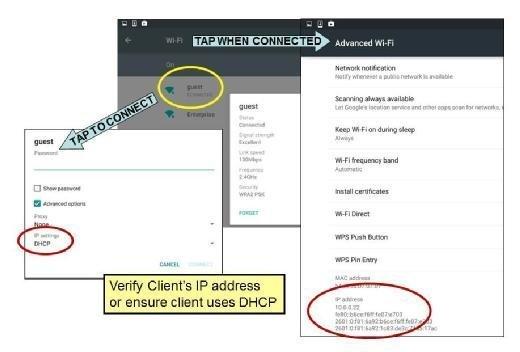How to troubleshoot Android Wi-Fi connection problems
Android smartphone and tablet users now abound in the enterprise, making Android Wi-Fi connection troubleshooting a key element of enterprise wireless network connection management.
ByIn our wireless network troubleshooting tip, we explained how to debug physical, AP, router and Windows connection problems. But what if you're having trouble with Android Wi-Fi connections on a smartphone or tablet? Check out these step-by-step tips for Android device Wi-Fi connection troubleshooting.
Start by verifying that a wireless access point (AP) or router is nearby and actively offering Wi-Fi service. Always start here, using another Wi-Fi client to determine which is the likely culprit, the network or the client. If multiple clients are unable to connect, follow instructions in our wireless network troubleshooting tip to debug probably AP or router or upstream network problems. Otherwise, proceed to step 2 to debug the affected Android client.
Verify that your Android Wi-Fi adapter is enabled.Before going any further, make sure that your Android device's Wi-Fi radio is not in Airplane Mode and that Wi-Fi is on and ready to connect. Tap Settings > Wireless & Networks > Wi-Fi as shown in Figure 1.
If Wi-Fi is off, tap the slider to turn Wi-Fi on. When Wi-Fi is on, a signal indicator appears at the top right corner of your home screen. Properly connected Wi-Fi takes precedence over mobile broadband, but it can be helpful to disable your device's mobile network connection while debugging Wi-Fi.
Verify your Android client is connected SSID and IP address.Return to your Android device's Settings > Wireless & Networks > Wi-Fi panel and tap Wi-Fi Settings. Find your network's name (SSID) on the list of nearby Wi-Fi networks.
Learn about Wi-Fi’s shortcomings, the impact of its inefficiency and inadequate performance and why you may need to consider a new approach.
Download nowNote that whenever you're trying to connect an Android Wi-Fi client to any network name, status is displayed on the Wi-Fi Settings panel, in the row labeled Wi-Fi. When status is Connected, tap Advanced to view the client's assigned IP address.
Once your Android Wi-Fi client has a valid IP address, usePingto verify network connectivity.Most Android devices do not include a user-accessible ping app, but you can still verify network connectivity as follows.

If your Android Wi-Fi client still cannot connect, get a valid IP address or ping any other system connected to the same subnet, it's time to look for wireless-specific problems.The AP/router and client must use compatible 802.11 standards. Please note the following:
To determine which 802.11 standards your wireless network’s AP or router supports, look for “Wi-Fi certified” logos, or search for Wi-Fi certified products at the Wi-Fi Alliance website.
In general, newer APs and routers are required to provide backward compatibility with older generations of Wi-Fi, but data rate settings must still match. Once you have confirmed that your AP or router and client should be compatible, debug wireless radio settings as described in our wireless network troubleshooting tip, step 6.
If a compatible wireless client and AP/router can "hear" each other but still cannot connect or exchange traffic, look for a security mismatch.The client must support the security mode required by the AP or router: Open, WEP, WPA, or WPA2. Unless a WLAN is open (i.e., unsecured), both endpoints must be configured with (or dynamically receive) identical keys to encrypt traffic between them. Compare security settings on your AP/router and Android Wi-Fi client and attempt to match them.
If you choose the wrong security type when adding a network, it may still be saved. You can change the password (or any other security parameter) associated with a saved network by tapping the network's name. However, it is often easier just to click Forget for any misconfigured network and start fresh.
Ensure RADIUS is working.WPA-Enterprise and WPA2-Enterprise log the Android Wi-Fi client into the network and deliver encryption keys using an 802.1X-capable RADIUS server. Refer to our network troubleshooting tip, step 8, to check your AP or router's RADIUS settings.
If RADIUS is working but your Android Wi-Fi client's connect requests are rejected, look for an 802.1X Extensible Authentication Protocol (EAP) problem.Your client must support one of the EAP types required by your RADIUS server and must supply a valid login.
If the only entry in the list is unspecified, you must first add a certificate file to your device. To do so, copy a certificate to a storage location accessible from your device (see Figure 6). Hint: Email the file to yourself and save it to your device, or upload the file onto Google Drive.
See Lisa Phifer's step-by-step instructions on troubleshooting wireless connection problems and iPhone and iPad connection problems.
Next, go to the Settings > Security panel. Tap Install from storage and choose the storage location of your certificate file. You may be prompted for a password to unlock the file. The certificate will be loaded into your Android device’s credential storage and should now appear as an option when selecting an EAP-TLS client or CA/RADIUS server certificate.
If your Android Wi-Fi client still cannot seem to connect to the network, seems very slow all the time or disconnects frequently, you may be experiencing lower-level wireless problems.Refer to our network troubleshooting tip, steps 10 and 11, for further instructions. To facilitate debugging, you may also want to install a few more free apps. For example, see the following:
Learn more about mobile operating systems in this Essential Guide
Are you ready to start developing for Android?
This was last published in October 2015







